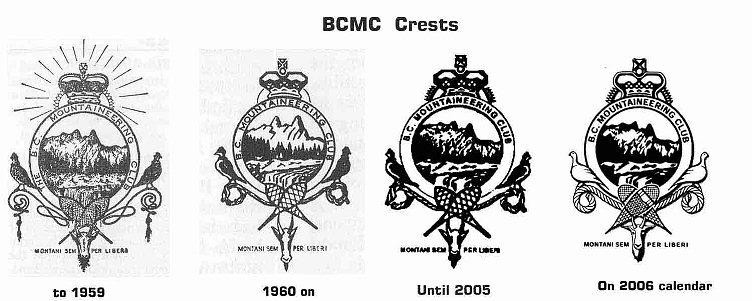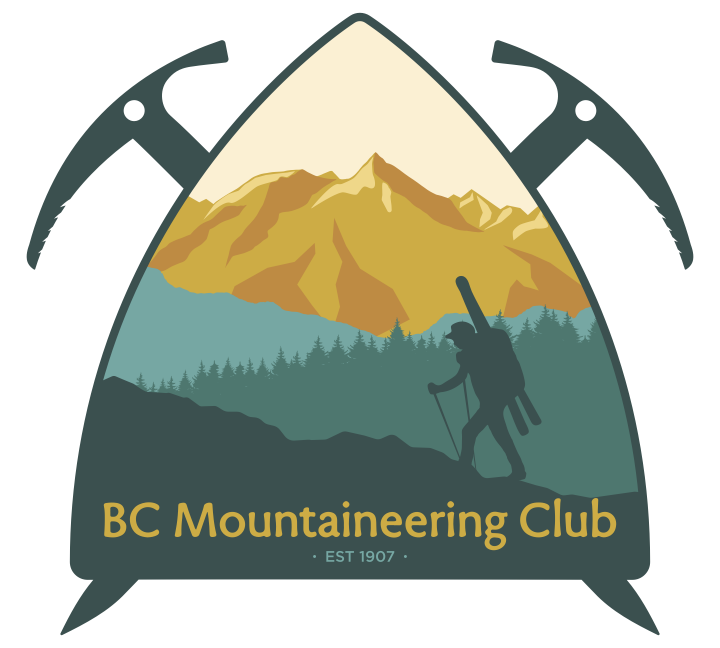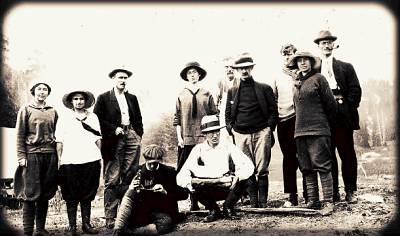| A brief overview of the history of the British Columbia Mountaineering Club from 1907 to 2007. |
The British Columbia Mountaineering Club (for the first year it was called the Vancouver Mountaineering Club) was started in Vancouver on October 28, 1907 at a meeting called by a small group of local mountaineers. At the next meeting in November the Club’s objectives were adopted: they have always included exploration of the BC Mountains, the preservation and protection of significant alpine areas in BC and all scientific, artistic and recreational activities to promote those objectives. At the same meeting a “A chaste and artistic design for a crest was prepared and presented by Mr. A. E. Sherman. It is the one which has been in use ever since, and shows the best-known and most climbed peaks near the city: The Lions, Crown, Goat, Dam and Grouse” (quotation from the club’s first publication, the 1913 “Northern Cordilleran”).
Click Here to view the complete list of past BCMC Presidents (1907 - 2024)
Click Here to view the complete list of Honorary Members and Other Honours (1907 - 2024)
(Coming Soon) to view the complete list of past BCMC Board of Directors (1907 - 2024)

New BCMC 2023 Logo
MEMBERSHIP
The Club grew as it organized weekend trips to the North Shore mountains, public lectures given by prominent club members and summer club camps in locations suitable for mountain climbing and hiking, primarily in what is now Garibaldi Park. Within a few years the Club had formed subgroups of members such as the Botanical (later the Natural History), the Geological and even an Entomological Section, whose pioneering efforts on Club and private trips are accorded a large portion of the space in the Northern Cordilleran. Following a slight dip in membership during the 2nd world war, membership has grown steadily to well over 500 members today.
In a 1957 article, “Early days of the BCMC” Honorary Member R. M. Mills notes with great satisfaction that the BCMC was a very democratic group having members from a wide variety of professions and all levels of income from lawyers, land surveyors, bankers to nurses, stenographers, cigar maker, piano tuner and real estate men, “all gentlemen and gentlewomen.”. It is well to remember that the club from the very start in 1907 was a model of gender equality, the charter members elected a woman as Vice president at the first AGM!
TRIP SCHEDULE
 |
| A BCMC group in the Garibaldi area, 1914. From the BCMC Archives. |
One of the most important and also most continuous Club functions has been to provide a regular schedule of weekend climbing (and starting in the thirties, skiing and later even snow-shoeing) trips open to all members, most often led by the trip director or by more experienced members. This trip regime has always included the ideal of less skilled climbers learning “the ropes” from more experienced fellow members and leaders who knew the routes and the hazards of the climbs offered.
Past trips, particularly those undertaken prior to the construction of the highway to Squamish, involved more complicated transport arrangements and often two or three day walk-ins/-outs. Early trips to Black Tusk involved a boat to Squamish, then a train up the Cheakamus valley, followed by a 1 or 2 day hike. Most of the mountains in the Lower Mainland were first climbed by BCMC members. Expeditionary ski camps began in spring 1967, and involved access to the Manatee range by ski plane and use of snow caves instead of tents with a three day ski/walk-out along the Lillooet river. The party on this trip included a young John Clarke who then began numerous forays into unexplored backcountry and ultimately an Order of Canada award. Other ski expeditions followed, such as a crossing of the Pemberton Ice field, snow camps in the Manatee Range, the Lord River/Lillooet Ice field, the Whitemantle Group, at Dais Glacier near Mt. Waddington and even two summer ski expeditions near the Alaska Panhandle/Stikine area. Christmas ski camps have frequently been on the trip schedule.
The earliest club trips involved primarily hiking and scrambling. Mountain climbing, then rock climbing, then ski-mountaineering, then ice climbing trips were introduced. Today all types of trips, from 1 day to many days in length appear on the club trip schedule.
PUBLICATIONS / LIBRARY / ARCHIVES
The 1913 Northern Cordilleran has already been mentioned. In March 1923 a monthly newsletter was started which is now in its 90th year, having been published regularly in one form or another. Its first editor was the well-known climber Don Munday. Don and his wife Phyl Munday were members of the BCMC until 1930 during some of their early and productive years as the explorers of the mountains around Mt. Waddington or Mystery Mountain as it was known then.
Another special publication was the 1957 fiftieth anniversary issue called "The Mountaineer", which contains "a selection from articles submitted by members ..., and it is fitting that there is emphasis on the early days of the Club."
The longest serving and present journal editor is Honorary Member Michael Feller, who was newsletter editor for almost 30 years and is still editor of the club's bi-annual glossy journal - the "BC Mountaineer". A large special edition of this journal was produced for the club's centennial in 2007. This focused on the entire first 100 years of the club, including many historical articles written by club members. Two comprehensive indexes of club publications have been produced, covering all publications up to 1990. Work on the next index is continuing.
The BCMC has an extensive archive collection consisting mainly of written materials and photographs, dating since around 1905. This collection has been catalogued and organized, and photographs put into electronic format. All materials have been placed into the North Vancouver Museum and Archives, where they are available for viewing by the public. Additional information: The BCMC Archives.
The BCMC also has an extensive library, containing copies of all club publications, as well as local and international guide books, journals of the Canadian, American, and German alpine clubs, and many books about exploration of mountain ranges around the world, but particularly B.C., and mountaineering expeditions, particularly to the Himalayas. This library, available for use by club members, has been kept by different club members. Its current custodian is Waldemar Jonsson.
In the mid-sixties the BCMC joined other local hiking/climbing clubs in organizing a Mountain Access Committee to coordinate and improve trail work and maintenance in the mountains accessible from Vancouver and environs. In 1971 it was replaced by its more formal successor, the FMCBC. From 1966 to 1972 these two groups also published four editions of a "Mountain Trail Guide" , which, in the last issue, described 43 trails (with access and maps) in a radius of about a 150 km of Vancouver.
In 1967 the BCMC established a committee to write a more detailed and larger trail guide for the local mountains. The committee chair was entrusted to the able leadership of a Past President and Honorary Member, the late John Harris. With the help of many club members and other climbers/hikers input the first issue of "103 Hikes in South Western BC" was completed and published (by the Seattle Mountaineers) in 1973. It was an immediate success: three more revised editions were prepared over the years by Honorary Members Mary and David Macaree. BCMC member Jack Bryceland produced the fifth and sixth editions in 2001 and 2008. Over 100,000 copies of these trail guides have been sold and they have helped countless hikers find their way into (and back from!) the hills around Vancouver. Mary and David Macaree also prepared 6 editions of "109 Walks in British Columbia's Lower Mainland". Club members Alice Purdey (Honorary) and John Halliday are currently working on the 7th edition. The first 3 editions of Coast Mountain climbing guides (1965 - 1974) were produced by Honorary Member Dick Culbert, while Honorary Member Anders Ourom produced "A Climber's Guide to the Squamish Chief", published by the BCMC in 1980.
The Club has also assisted in the publishing of mountaineering guide books, such as "A Guide to Climbing and Hiking in South-western BC" (1986) and the "Stein Valley Wilderness Guidebook" (1991).
ENVIRONMENT
During its entire existence, the BCMC has been noted for its activism. The club and many of its members have often been involved in the struggles for the preservation of mountain wilderness, the creation of provincial parks, and protection of non-motorized outdoor recreation opportunities. These struggles by the club began in its earliest days when a campaign was launched in 1913 to have Garibaldi Park established. This campaign increased to a peak during the club's 1926 summer camp in Black Tusk Meadows. Shortly thereafter the park was established.
The BCMC and its members had long advocated park establishment at Hollyburn Ridge and a BCMC trip uncovered the uncontrolled logging in Cypress Bowl in the 1970s. BCMC members have been heavily involved in the establishment and management of Cypress Provincial Park ever since.
Increasing loss of wilderness and wilderness recreation opportunities in the 1970s lead the BCMC to establish a conservation committee and include a conservation chair on the club executive. This committee has been extremely active on many fronts. The BCMC committee has been subsumed by the FMCBC Recreation and Conservation Committee, but the BCMC has usually supplied more members to the FMCBC committee than any other FMCBC club. Since the 1970s the BCMC and its members have written countless letters, attended countless meetings, presented countless submissions, and sacrificed countless recreation days, in attempts to protect mountain wilderness and wilderness recreation opportunities. Examples of the more successful undertakings are -
- the active participation of many BCMC members in the wild and woolly days of the ROSS (Run Out the Skagit Spoilers) society, which contributed substantially to the dedication of the BC portion of the Skagit valley as a park;
- the 1973 submission to the Provincial Government of a detailed and impassioned brief by BCMC past President and Honorary Member Roy Mason for setting aside the Stein Valley as a Park;
- an extensive proposal for the preservation of the "Clendenning/Elaho/Upper Lillooet wilderness", an area now partially reserved in parks, by a youthful BCMC member Randy Stoltmann (who sadly died in an avalanche on a ski-touring expedition in 1994);
- efforts to establish Pinecone - Burke Provincial Park during the 1990s;
- efforts during the 1990s and 2000s through the Sea-to-Sky Winter and Summer Backcountry Recreation Forums and the Sea-to-Sky LRMP to protect wilderness recreation opportunities in the Squamish Forest District and have some areas off-limits to snowmobiling. The results look reasonable on paper, but the government has been unwilling and/or incapable of doing anything about snowmobiling. Areas such as those around the BCMC North Ck. Cabin, have been protected against road development and logging, however.
There are many more examples of the BCMC and its members working collectively or individually, in concert with affiliated groups, such as the Federation of Mountain Clubs (FMCBC) and the Climbers Access Society in the preservation and protection of BC's significant mountain landscapes. One of the best known is the late Honorary Member John Clarke, who, after achieving legendary status as a mountain explorer with many hundreds of first and other ascents, devoted the last eight years of his life to environmental education of BC school children and native youth.
ASSOCIATED GROUPS
As early as 1949 the BCMC was asked to supply volunteers to help out the First Aid Ski Patrol on Mt. Seymour during winter weekends and by1952 the RCMP and the Forest Service were assisted by a Mountain Emergency Squad, which later evolved into the Mountain Rescue Group (MRG), a registered society with local climbers, including many BCMC members, trained in rescue operations. It was prominent in search efforts for lost hikers on the north shore and during the high profile hunt for the vanished TCA North Star airplane, which was later found on Mt. Slesse by a climbing party. The MRG carried out many rescue operations on the local mountains and some members even assisted prominently in the avalanche disaster at the Granduc mine. The search and rescue role was later taken over by various local groups, who could respond more quickly and would have more specialized training, such as the North Shore Rescue.
MOUNTAINEERING TRAINING
Rock, snow and ice climbing instruction has been a regular part of BCMC activities for many years. In the sixties the BCMC even teamed up with the Vancouver School Board in offering spring evening classes combined with one or two weekend practices in mountain craft. Later the Mountain Rescue Group was assigned the role of climbing instruction, many times with experienced BCMC members as instructors. Following the demise of the MRG, the FMCBC became its successor in the 1970s. The FMCBC then took over climbing training, again frequently using BCMC members as instructors. Since the 1980s, when FMCBC training reverted to a private commercial company, mountaineering training, both beginners and advanced, has again been offered by the BCMC and a summer and winter training program has again become an important feature of the Club's schedule.
CABINS AND TRAILS
Since even before its inception, the BCMC has been actively involved in hut and trail construction and maintenance. Some of the key charter members of the BCMC had built a cabin on Grouse Mtn. in 1906. This cabin was used by the BCMC after the club formed, but was soon replaced with a larger cabin in 1910, then another in 1926. Two cabins were built on Mt. Seymour in 1933 and 1940. Five cabins were built in the 1965 - 1970 period, in the Lucky Four Group, Chilliwack valley (soon destroyed by an avalanche), near Singing Pass and Wedgemount Lake, Garibaldi Park, at Mountain Lake, above Brittania Beach, and near the Tellot Glacier, Mount Waddington area. Another cabin was built in 1986 in the North Ck. Valley. Recent attempts to construct another cabin have encountered problems in finding a suitable location.
The BCMC and its members have been building and maintaining trails throughout southwestern BC again since even before the club's inception. The BCMC trail on Grouse Mtn. is a legacy of the various trails the club built on Grouse to access its cabins and the upper slopes. The first trail to the Black Tusk Meadows was cut by the BCMC under the leadership of then club president Billy Gray in 1912. Many of our Lower Mainland trails, such as those to Williamson Lake, the Lions, the Squamish Chief, Singing Pass, Wedgemount Lake, and North Ck., owe their existence partly or completely to Paul Binkert, an Honorary Member and Honorary BCMC President from 1980 to 1995. Paul started organized trail building by the BCMC in 1959 and chaired the BCMC's first trail committee in the 1960s. Many other BCMC members, but notably Pat Crean, Sev Heiberg, Paul Kubik, Chris Ludwig, David Scanlon, and Ed Zenger, have organized trail building and maintenance trips during the last 30 years.

